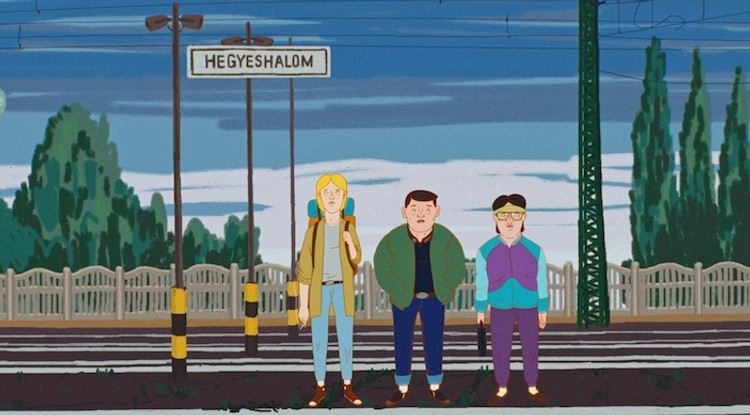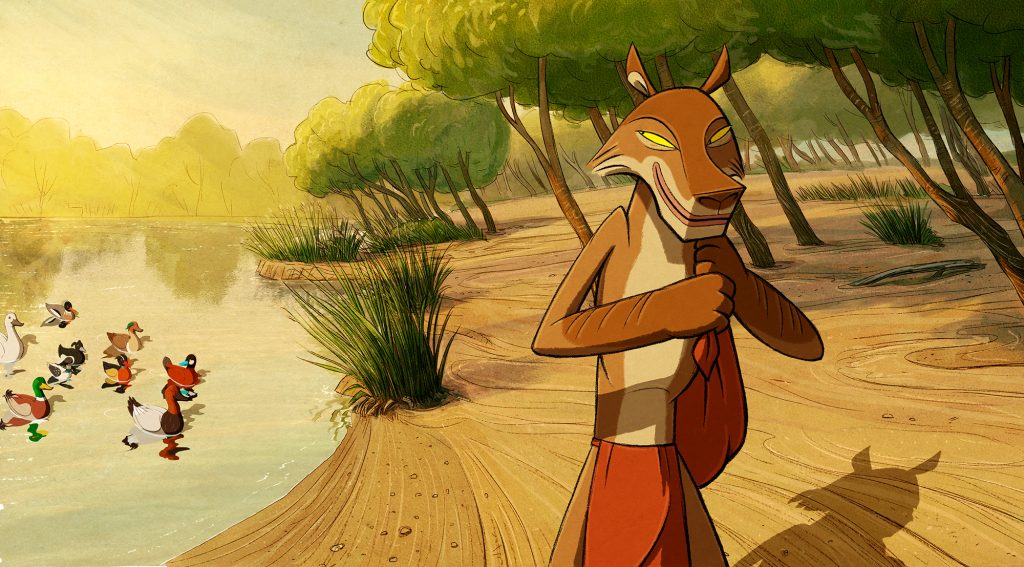



Award-winning Hungarian animated films you need to know
Starting in 2013, the second Hungarian animation wave, marked by films like Rabbit and Deer and Symphony no. 42, ushered in a new era of creative and global recognition. Here, we spotlight some of the most remarkable films that have emerged since.
March 2023 marked the first time in decades that two feature-length Hungarian animated films were released within two weeks: Four Souls of Coyote and White Plastic Sky. Four Souls of Coyote, the second feature-length animation by Áron Gauder, director of the Annecy Cristal-winning District (Nyócker!), took nearly ten years to complete. The director has been interested in and inspired by Native American culture since childhood (he even attends Indian camps!), and legendary musician Tamás Cseh brought him even closer to this world. Cseh had an in-depth knowledge of Native American culture in Hungary and translated many Native American folktales. Gauder adapted these stories in Four Souls of Coyote.
The film is a prequel to two short films featuring Coyote, based on the Native American tales translated by Tamás Cseh in 2006. Gauder developed the idea into a feature-length film, co-writing it with Géza Bereményi, Tamás Cseh’s longtime writing partner. The story retells the Native American creation myth, with the mythical figure of Coyote at its center. Through this creation myth, the film addresses the fundamental question of how we can live in harmony with our environment before it’s too late – and how not to bring about our own destruction on Earth.
Four Souls of Coyote was produced by Cinemon Entertainment with the support of the National Film Institute Hungary, on a budget of nearly HUF 800 million (around €2 million), and produced by Réka Temple. The music was composed by contemporary Native American musicians, and the English-dubbed version for international audiences features the voices of Native American artists.
Gauder’s film has been screened at more than 50 festivals and received numerous accolades, including a nomination for the Annie Award. It won the Jury Prize at Annecy, the Grand Prize for Feature-Length Film at Cinanima, and Best Animated Film at the Shanghai Film Festival.
Tibor Bánóczki and Sarolta Szabó’s debut feature-length animation, White Plastic Sky, was one of the winners of the National Film Institute’s first Incubator Program in 2015 (a program for first-time filmmakers). However, it soon became clear that the film’s high production quality exceeded the scope of the programme. In addition to further support from the NFI, the project received backing from the Slovak Audiovisual Fund and, later, from the Council of Europe’s film fund Eurimages. It was a Hungarian–Slovak co-production, with a total budget of HUF 813 million (approximately €2.4 million). The film was produced by József Fülöp and Orsolya Sipos (SALTO Film), and Juraj Krasnohorsky (Artichoke), and co-produced by Viktória Petrányi (Proton Cinema) and RTVS – Radio and Television Slovakia.
In this dystopian science fiction film, created using the rotoscope technique, scientists experiment with a plant implanted into the human body after the destruction of Earth’s flora and fauna. Everyone is required to undergo the procedure at the age of 50. The protagonist’s wife volunteers well before her 50th birthday, and the man breaks every rule to save her – setting off on a journey where the two find each other again, come to understand one another, and make peace with their past.
The film had its world premiere in the Encounters competition section of the Berlinale in 2023 and went on to a successful festival circuit – from the United States to the Czech Republic, from the Netherlands to Asia. It was nominated for an Annie Award in the same year as Four Souls of Coyote, received a European Film Awards nomination, and won the Silver Méliès Award for Best Feature Film at the Strasbourg European Fantastic Film Festival.
Released in 2024, Pelikan Blue is Hungary’s first feature-length animated documentary, exploring the wave of train ticket fraud in Central and Eastern Europe during the 1990s. After the fall of communism in 1989, borders opened and people were free to travel. Three resourceful friends discovered that MÁV (Hungarian State Railways) tickets could be reused, so they began experimenting with a simple method of creating their own tickets using blue Pelikan ink. They sold the tickets to their friends, then to their friends’ friends, and so on.
Director László Csáki is personally connected to the story, as he was among those who took advantage of this train ticket opportunity. The idea for the project began in 2006, but its form evolved over time – from a live-action film to an animated short, and ultimately to a full-length animated documentary. Initially, Csáki gathered material himself by interviewing people from whom he had purchased fake tickets. Later, he expanded his research to include MÁV workers, a policeman, and other passengers who shared their own experiences with this method of travel. Pelikan Blue is a true nostalgia trip, featuring reconstructed scenes alongside original interviews, using 2D and stop-motion animation, as well as scenes shot with a Super 8 camera. In addition to objects from the period, the film includes many emblematic pieces of 90s music from Eastern Europe.
Pelikan Blue was also a winner of the Incubator Program in 2019, made with a budget of HUF 89 million (about €220K). The film was produced by Ádám Felszeghy and Miklós Kázmér (Umbrella Entertainment), with co-production by Réka Temple (Cinemon Entertainment). The animated documentary has traveled the world and won numerous awards, including the main prize at the ANIMIX International Animation & Comics Festival, the Golden Dove Award for Best Feature-Length Animated Film at Dok Leipzig, Best Feature Film at Animest, the Audience Award at the Animator Festival, and the Special Jury Prize at Animafest.
Flóra Anna Buda’s first independent animation, 27, follows her diploma film Entropia after graduating from MOME. 27 reached the top at its very first festival, winning the Palme d’Or for Best Short Film at Cannes and, shortly afterward, the Cristal for Best Short Film at Annecy. The French-Hungarian co-production stars 27-year-old Alíz, who still lives with her parents. During a night of intoxication on her birthday, she realizes that it’s time to say goodbye to illusions and face the reality around her. The film was inspired by an autobiographical situation – one that resonates with many young people around the world: living at home with parents because they can’t afford to live on their own. As Flóra shared, she had to choose between moving away from home or staying and making this film. She chose the latter.
The director developed the project at the Open Workshop in Viborg and later won the Ciclic Prize at the MIFA pitch forum in Annecy in 2020. This win allowed her to spend six months in France at the end of 2021, further developing her film. The award also included a €35,000 cash prize. After the film’s successful debut, it toured the world’s film festivals. In addition to the two awards mentioned above, the film won the Heart of Sarajevo at the Sarajevo Film Festival, Best Animation Short Film at the Melbourne International Film Festival, and Best World Animation at the Leeds International Film Festival. It was also nominated for a European Film Award, shortlisted for the Academy and César Awards, and even screened as an accompanying film in Hungarian cinemas.
27 didn’t receive a grant from the National Film Institute Hungary, despite several applications from the producers. It was produced by the French company Miyu (producers: Emmanuel-Alain Raynal and Pierre Baussaron) and the Hungarian company Boddah (producers: Gábor Osváth and Péter Benjámin Lukács). The film had a budget of HUF 50 million (around €123K). Flóra is currently developing her new film project as part of the Résidence Programme at the Cannes Film Festival.
Another notable Hungarian short animation festival success in recent years was also directed by a woman: Shoes and Hooves by Viktória Traub, the creator of Iron Egg (Vastojás, 2014) and Mermaids and Rhinos (Sellők és rinocéroszok, 2017). The film is set in a surreal, hybrid world inhabited by human-animal creatures. It tells the story of Paula, a centaur girl who longs for human legs and falls in love with a crocodile man. Their relationship raises themes such as attachment, conformity, and self-acceptance.
Shoes and Hooves debuted at Animafest Zagreb, competed at the Annecy International Animation Film Festival, and toured the world – from Zagreb to Gdansk, Brussels, Lisbon, and Vancouver. The film won Best Short Film at the Oscar-qualifying Guanajuato International Film Festival, Best Short Film at the Viborg Animation Film Festival, and a special prize at the Go Short International Film Festival.
The film was produced by Polett Dus (Pi Productions), with co-production by Solaz Media and Paprika Studios, support from TV Paint, and post-production at NFI Filmlabor. It was made with support from the NFI and had a budget of HUF 14.3 million (around €35K). Viktória has since been working on a new film project exploring the loss of illusions and the desire to grow up.
The most recent highlights of Hungarian animation include the Berlinale Generation+ winner Wish You Were Ear by Mirjana Balogh, and The Last Drop (Az utolsó dobás) by Anna Tőkés, both MOME Anim diploma films that competed in the graduation programme at Annecy. Another notable film is Dog Ear (Kutyafül) by Péter Vácz, which began its festival circuit at this year’s Annecy. This marks Péter’s first animated short since the multi-award-winning Rabbit and Deer.
Zsófi Herczeg

